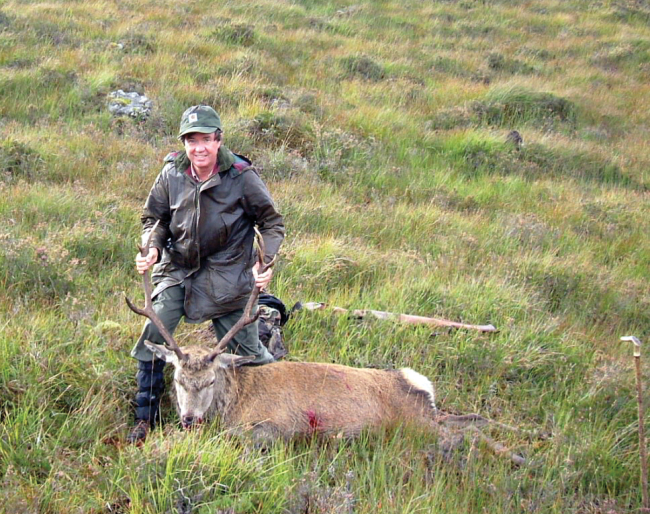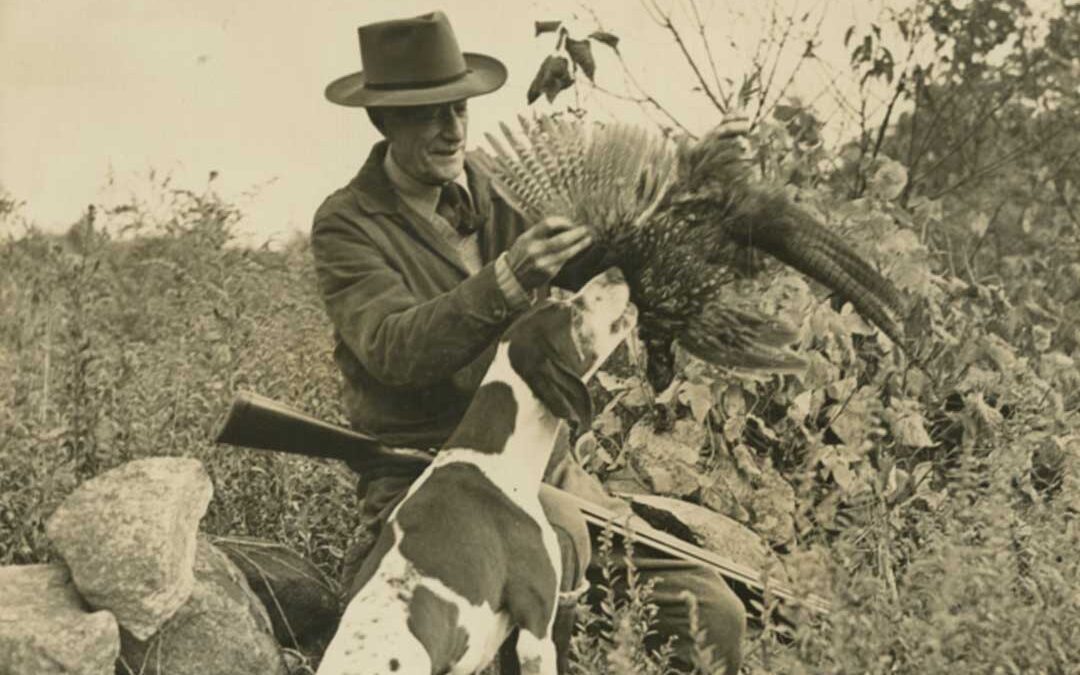Angler, hunter, and above all artist, Lynn Bogue Hunt was the most popular and prolific outdoor illustrator in mid-20th century America. He painted a record 106 covers for Field & Stream in addition to numerous covers for other publications; illustrated dozens of books on waterfowling, upland bird hunting, and saltwater fishing (not coincidentally, his three main interests as a sportsman); and published several portfolios of his paintings to enormous acclaim.
He was a bon vivant, too. Perpetually tanned and angularly handsome, he cut a dashing figure in any company. He was as comfortable twisting a lemon peel into a martini at a poolside cocktail party as he was rigging a complicated trolling bait on the deck of a pitching sport fisherman.
Hunt fished, hunted, and hobnobbed with the most famous outdoorsmen of his day: Van Campen Heilner, S. Kip Farrington, Ray Holland, Zane Grey, and, oh yeah, that Hemingway guy. Hunt even did a painting of a semi-tame quail that Hemingway and his third wife, Martha Gellhorn, kept at Finca Vigia, the home in Cuba that looms so massively in the Hemingway mythology.
Born in Honeoye Falls, New York, (near Rochester) in 1878, Lynn Bogue Hunt mostly grew up in Albion, Michigan. With the support and encouragement of his mother, who’d left Hunt’s rainbow-chasing dad back in New York, he kept a menagerie of wild pets; spent as much time as he could hunting, observing nature, and simply tramping around outdoors; learned taxidermy when he was in his teens; and sketched constantly from the time he was a little boy.
-

Sometime after his hunt at Barnegat Bay along the New Jersey coast, Hunt created “Broadbill Shooting from a Sneak Box” for Eugene’s Connett’s 1947 book, “Duck Shooting Along the Atlantic Tidewater.”
While still in high school he took painting lessons from a professor at Albion College, and in 1897, while a student at Albion himself, he made his debut on the national stage with “A King of Game Birds,” a ruffed grouse story for Sports Afield that he both wrote and illustrated.
In 1903, after honing his skills for three years as a staff artist at the Detroit Free Press, Hunt moved to New York City, where he hung out his shingle as a freelance illustrator and never looked back. He cleared $3,500 his first year in the city, a tidy sum in those days. In addition to magazine illustration, he did all kinds of advertising work—calendars, posters, catalog covers, you name it.
-

“Flaring Broadbills,” a gouache painting completed in the 1940s.
A signal event in Hunt’s career came in 1917, the year he turned 39. That’s when DuPont published Our American Game Birds, a magnificent portfolio of 18 full-color Hunt reproductions of upland gamebirds, shorebirds, and waterfowl. It became wildly popular with sportsmen, putting Hunt on the map and firmly establishing him as the gamebird artist of his time.
Still, it wasn’t until 1924, when he began his remarkable run at Field & Stream, that he truly arrived. Every year from 1924 through 1947 Hunt did as many as seven and never fewer than two covers for F&S. He also provided sketches and line drawings, literally by the hundreds, to illustrate various articles for the magazine.
For example, Hunt did the original drawings that accompanied one of Gordon MacQuarrie’s best-loved stories, the duck-hunting yarn, “The Little Flight.” He wrote for F&S on occasion, too, including a memorable account of fishing for striped bass in the crashing surf off Montauk Point called “Striped Bass and Ol’ Devil Sea.”
-

A prolific illustrator, Hunt produced drawings and paintings not only for “Field & Stream,” but for many other magazines and books. This charcoal and gouache drawing was done for a book illustration in 1904.
In the words of longtime F&S Editor David E. Petzal: “Of all our cover artists, the most famous and arguably the most successful was Lynn Bogue Hunt . . . Hunt would submit a watercolor ‘rough’ of a cover to the editor and, when it was approved, would redo it in oil. Like Audubon, Hunt shot and mounted many of the birds and mammals he painted. He relied on friends who brought him photos of their adventures and was himself an active hunter and fisherman.”
Adds Petzal: “What made Hunt stand out among so many gifted peers? George Reiger, an authority on Hunt, puts it this way: ‘His subjects were simply more real. How do you paint something alive? You paint life. That’s what Hunt did. He painted life.’”
In a sense, Reiger was only echoing something another legendary Field & Stream figure, Ray Holland, said of Hunt’s work in the 1940s.
“When you are looking at one of Lynn Bogue Hunt’s paintings,” stated Holland, “the bird is right, it is acting right, and the surroundings are right.”
-

Hunt did this gouache illustration for “Broken Fang,” a 1935 novel by R.G. Montgomery.
Hunt was, indisputably, the most famous outdoor artist and illustrator of his time. His work has come to define the look, feel, and abundant, unfettered spirit of what was truly a Golden Age of American field sports. Many of the books he illustrated are now considered classics, several of which, including his own An Artist’s Game Bag, were published by the famed Derrydale Press.
Perhaps the two best-known books Hunt illustrated, though—both Derrydales—were Grouse Feathers and More Grouse Feathers. Written by another legendary figure, Burton Spiller, they’ve charmed generations of readers. Spiller’s droll, humorous stories and Hunt’s evocative, beautifully realized drawings make for one of the happiest marriages of text and art in the sporting canon.
And if Hunt’s depictions of ruffed grouse and woodcock are unsurpassed, his line drawings of dogs, in particular his head studies of pointers and English setters, put him in a class with a scant handful of other artists—A.B. Frost, William Harnden Foster, and perhaps one or two more. Echoing George Reiger’s observation that Hunt’s art was “more real,” when you look at Hunt’s dogs, it’s as if you feel their velvety muzzles, leathery ears, and finely chiseled heads beneath your fingertips.
-

“Fighting Roosters,” a gouache sketch, circa 1930.
This, I think, is the key to Hunt’s best work. It was unfailingly authentic to the sportsman’s experience, yes—but even more than that, it triggered the machinery of dreams.
Another of Hunt’s distinctions was designing the 1939-’40 Federal Duck Stamp, the sixth in the series. What’s generally considered the high-water mark of his career, though, came in 1944 with the publication of Game Birds of America, a portfolio of 12 full-color prints issued by Field & Stream—and accompanied by great fanfare. Ernest Hemingway himself weighed in with an endorsement, while David Newell, another prominent sportsman, writer, and editor of the day, stated, “There are many artists who can paint. There are a few artists who can paint wildlife, but there are a very few artists, indeed, who can paint wildlife as the sportsman sees it in the field. Hunt can do this.”
Sadly, even tragically for a man who’d led such an intensely visual life, Hunt began losing his eyesight not long after that. At the end, in a kind of cruel irony, he couldn’t see well enough to paint the eyes of birds. Hunt painted his final cover for Field & Stream in 1951, cleaned his brushes for the last time in 1953, and lived in semi-seclusion at his home in western Long Island until his death, at the age of 82, in 1960.
-

Hunt painted “Deadly Encounter” for the December 1938 cover of “Field & Stream.”
One of his pleasures in old age was listening to the music of Harry Belafonte, and only days before he died he visited Sagamore Hill, the home of his great hero Theodore Roosevelt. An obituary in the New York Times described Hunt as “the Audubon of his time,” a characterization that undoubtedly would have pleased him.
He once told a friend: “I guess that I was just born with the ability to do this kind of work—and I thank God that I found my vocation. My work and play are one and the same thing—no man could ask for anything more than that.”
The “Hunt” Guy
-

Paul Vartanian has amassed not only the largest LBH collection in the world, but likely the largest collection of any sporting artist’s work.
In the mid-1980s a New Jersey sportsman named Paul Vartanian was introduced to a sporting art dealer from Brooklyn named Shelly Spindel—it was like introducing gasoline to a lighted match. Spindel, who longtime readers of Sporting Classics will remember as its original “answers man” for questions about sporting collectibles, turned Vartanian on to Lynn Bogue Hunt . . . and the rest is history.
Within a few years Vartanian had amassed not only the world’s largest collection of Lynn Bogue Hunt paintings and drawings, but what is in all likelihood the largest and most complete collection of the work of any major sporting artist.

